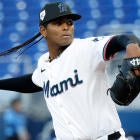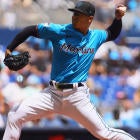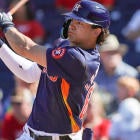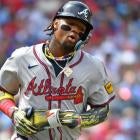
On May 20 in this blog, I asked a very simple question: "Can Taijuan Walker be fixed?" At the time, he had a 7.47 ERA and 1.85 WHIP, along with one of the worst walk rates in baseball. Given the Mariners' dreams of contention, it wasn't crazy to think he might have been on the fast track back to the minors with that kind of performance.
He had one more subpar start May 24, in which he gave up four runs in 5 2/3 innings, with more walks (4) than strikeouts (3). Since then, Walker has been one of the best pitchers in baseball, lowering his ERA all the way to 4.53, where it stands now. That might not sound like much, but it is enough to make him the No. 2 pitcher in Rotisserie scoring since May 29. He has improved dramatically in that time, as you can see:
| Timeframe | IP/GS | Strike% | ERA | K% | BB% | SwStr% |
| Before May 29 | 4.8 | 62.0 | 7.33 | 18.8 | 11.11 | 9.9 |
| Since May 29 | 6.8 | 69.0 | 2.32 | 26.3 | 1.95 | 13.3 |
Where did this turnaround come from? Were there any warning signs that he was about to turn things around? Not really. On May 20, Walker had the sixth-highest exit velocity against among starting pitchers, per BaseballSavant.com, and didn't have a reliable breaking pitch to lean on; he threw his splitter 16.9 percent of the time, but opposing batters were hitting .447 against it, while swinging and missing just 11.4 percent of the time against it.
Those weren't exactly promising signs, especially if I told you that, from that point on, he would actually become even more reliant on that splitter. And yet, that splitter is the key to his turnaround.
On May 28, Walker was picking up a swinging strike on 9.5 percent of his four-seam fastballs, while throwing it 65.9 percent of the time. He has increase his usage of both since, to 71.1 percent and an 11.0 swinging strike rate, but those aren't huge jumps; the huge jump has come with his splitter. Over his last eight starts, Walker's splitter has become a true weapon. He has thrown it 146 times while picking up 36 swinging strikes. That's a 24.6 percent rate, a huge improvement. Opposing hitters have managed just a .143 average against it, and the numbers are even starker against left-handed batters; he has thrown it 22.5 percent of the time to lefties, with a swinging strike rate of 23.2 percent and a batting average of .132.
In that earlier post, I noted that Walker's high free pass rate wasn't necessarily the result of his inability to throw strikes, as he was in the strike zone more often than nearly all pitchers in baseball. The problem was that he was inducing a swing on those pitches outside of the zone just 25.3 percent of the time. If batters are able to lay off those pitches outside of the zone, you're going to have trouble staying ahead of batters no matter how good your control is.
Since May 20, Walker's percentage of pitches inside the strike zone has actually gone down slightly, to 37.4 percent. However, he has made up for that by drastically improving the rate of pitches outside of the strike zone he has been able to induce a swing on. That has jumped all the way to 35.8 percent of his last nine starts, a number that would rank eighth in the majors; he was in the bottom-20 before.
For what it's worth, Walker's increase reliance on the fastball-splitter combination has actually left him running a reverse split for the season, with right-handed batters posting an OPS 68 points higher than lefties against him. This is probably a natural result of him becoming much less reliant on his cutter/slider and curveball, as he has thrown them just 9.2 percent of the time since May 29, compared to 18.2 percent before. The next step in his evolution might be working his breaking pitches back into his repertoire to combat some of his issues against righties.
If there is one lesson to take from Walker's season so far, it is probably this: What has happened so far is not necessarily a sign of what will happen in the future. His improvement basically came out of nowhere, and the change that fueled it couldn't really have been predicted. Given his age, betting on his upside wasn't a bad idea, but if you dropped him in April or May, it is hard to blame yourself for that decision either.
Where should expectations for Walker fall from this point on? Well, you probably can't expect him to be the second-best pitcher in Fantasy moving forward, to start. On the other hand, he has been so good that any expectations of failure on the level of his first two months are out the window as well. Realistically, he can be a top-25 pitcher from this point on, though his age and track record gives him a wider range of possible outcomes than most pitchers in that range.
Not bad for someone you might have picked up on waivers just a few months ago.





















